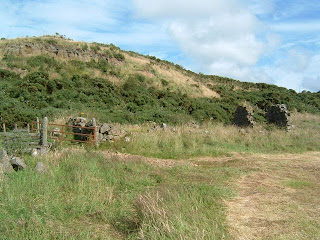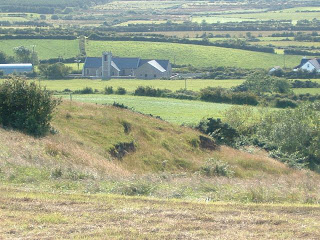 Some have admired the waters far below the gently swaying 'fish-net' Carrickarede rope bridge; I've admired both from a distance!!
Some have admired the waters far below the gently swaying 'fish-net' Carrickarede rope bridge; I've admired both from a distance!!
In days of yore young men from Croaghmore rode their bicycles, allegedly, across the then single guide roped and very open fisherman's bridge.
[Starrs' postcard link]
The Giants Causeway and Carrickarede Rope Bridge are just two of the highlights
of the Baronies of Cary and Upper and Lower Dunluce in the north of County Antrim.
Sunday 29 July 2007
Carrickarede rope bridge
Carrickarede rope bridge
Some have admired the waters far below the gently swaying Carrickarede rope bridge; I've admired both from a distance!! In days of yore young men from Croaghmore rode their bicycles, allegedly, across the the then single guide roped and very open fisherman's bridge.
Friday 27 July 2007
The power of Google
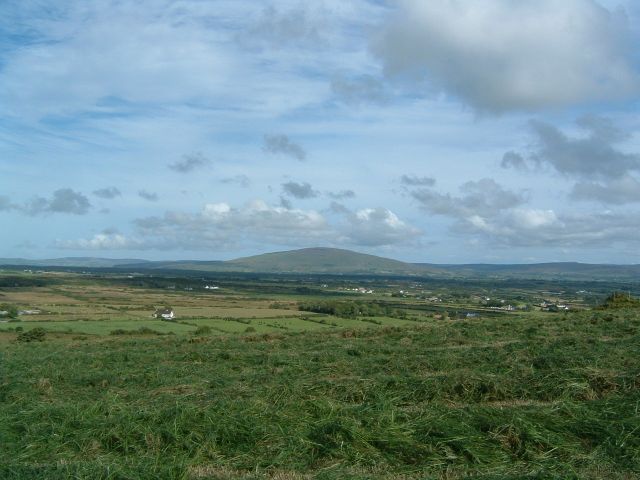 The Croaghmore poem and its as yet unidentified 'maker' have aroused my curiosity. So I did a little 'googling'. The search brought up a link with names and places from North Antrim.
The Croaghmore poem and its as yet unidentified 'maker' have aroused my curiosity. So I did a little 'googling'. The search brought up a link with names and places from North Antrim.There was McConaghie from the Cozies, Henderson from (Croaghmore,) Co Antrim, McGugan from Ballyoglagh, McKillop from Croaghmore and some others. The researcher in the link looked as if he might be a relation of a friend of mine.
I tried the email address but it was obsolete. I next tried USA 411 and found a couple of names that looked promising. I made two phonecalls, found one person at home and left a contact email address. The reply arrived this morning. The researcher is also a relative of mine (by marriage). What a small world we now inhabit!!
PS The above photo shows Knocklayd seven miles east across the plain from Croagh. Just click on the image for a larger view.
Thursday 26 July 2007
Old Bushmills at the Smithsonian
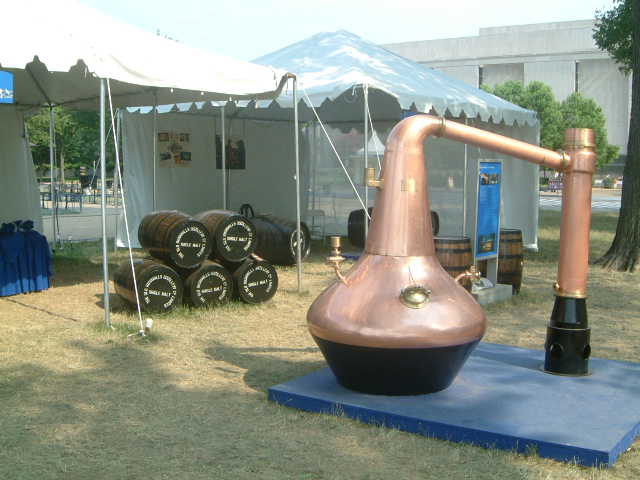 This photo was taken by Davy Gault, a friend and a member of the Old Bushmills team that participated in the recent 41st Annual Smithsonian Folklife Festival in downtown Washington, DC. Perhaps the festival will add to the growing number of visitors to North Antrim
This photo was taken by Davy Gault, a friend and a member of the Old Bushmills team that participated in the recent 41st Annual Smithsonian Folklife Festival in downtown Washington, DC. Perhaps the festival will add to the growing number of visitors to North Antrim
McKeemans on the move
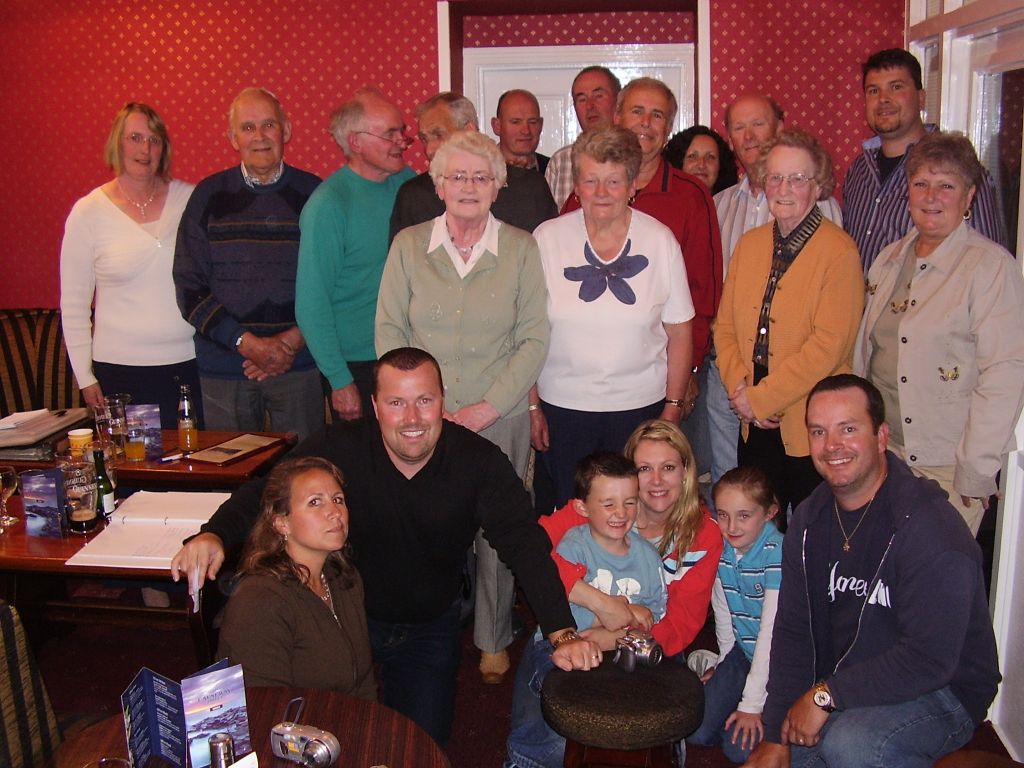 The origins of the McKeeman name are uncertain. MacLysaght's "The Surnames of Ireland" has Mac Shíomóin. A gaelicized form of Fitzsimon found in Ulster.
The origins of the McKeeman name are uncertain. MacLysaght's "The Surnames of Ireland" has Mac Shíomóin. A gaelicized form of Fitzsimon found in Ulster.The name is relatively rare. I've noted McKeemans in the adjacent townlands of Ballyoglagh and Craignamaddy in 1734 and on the west side of the River Bann: Dunboe, Macosquin, Aghadowey and Garvagh. Rev Mullin's "Families of Ballyrashane" mentions a Gilbert and John McKeeman in Lisnarick in 1779; these McKeemans have disappeared prior to the 1832 Tithe applotment. John Kimin in the 1666 Hearth Money Roll in the parish of Billy might be a McKeeman.
Mary, one of my Ballyoglagh Taggarts, married her next farm neighbour, James McKeeman, in Toberkeigh Presbyterian Church in 1856 and I think James was a very close relation of the David Charles McKeeman of Ballyoglagh who emigrated to the USA circa 1850. David and his wife Margaret (Peggy) McConaghy of Deffrick were married in Croaghmore Presbyterian Church and eventually settled in Indiana.
We've had several McKeeman visitors in North Antrim this year - and there are more to come!! Ed Hotham is from Pennsylvania and his McKeeman roots are in Craignamaddy. The photo was taken at a McKeeman 'gathering' in the Giants Causeway Hotel in June and includes Neal McKeeman of Indiana, a descendant of David and Peggy, some members of his family and folks with links to both the Ballyoglagh and Craignamaddy McKeemans. Bonnie Kelley of South Carolina was touring with other Kelleys; her mother was an Indiana McKeeman from the David and Peggy line. Peter McKeeman is coming over from Scotland in September but his McKeeman roots here have yet be found.
Charmed by County Antrim
Tuesday 24 July 2007
Bushmills exhibition II
The Robert Quigg VC medal was on display for a few hours today. It was brought to the exhibition by Capt Jackie Knox and Col W R H Charly of the Royal Ulster Rifles Museum, Belfast and they're included in the picture with Mrs Jean Henry, Coleraine, a niece of Robert Quigg VC, and holding the medal, and Robert Thompson and Glenda Rodgers.
Monday 23 July 2007
William Erigena Robinson
 I am (still) searching for a book, "The Irish in America", written by William E(rigena) Robinson. It was published in America about 1878. One of the families mentioned is Clinton! [Erigena means native of Ireland.]
I am (still) searching for a book, "The Irish in America", written by William E(rigena) Robinson. It was published in America about 1878. One of the families mentioned is Clinton! [Erigena means native of Ireland.]William Robinson was a member of Congress for Brooklyn in the 1870's and, as a newspaper columnist, was known as Richelieu of the Tribune - according to the New York Sun, of the 22nd September 1878. He had a brother James in Coleraine and a brother John in the neighbouring town of Ballymoney.
The Sun tells us that William devoted much of his research to "the immigration to this country from Ireland prior to the Revolution" (War of Independence). He claimed that the Irish were pioneers of American education and that one particular Irishman (unnamed) gave presidents to Hampden, Sidney, Princeton and Union Colleges.
In his book "The Irish in America" (published circa 1878) there are full accounts of Carroll, Livingstone, Preston, Meade and Clinton plus details of Adams, Aiken, Alexander, Alison, Armstrong, Beatty, Blair, Black, Brown, Burke, Butler, Caldwell, Calhoun, Campbell, Chambers, Clarke, Crawford, Davidson, Ewing, Finlay, Floyd, Fulton, Gibson, Graham, Hall, Harper, Houston, Iredell, Irvin, Jackson, Johnson, Johnston, Kennedy, Logan, Lynch, Morton, Marshall, McDowell, McKean, Montgomery, Moore, Morse, Nelson, Porter, Polk, Pollock, Patterson, Read, Reid, Rodgers, Rutherford, Rutledge, Smith, Speight, Stewart, Tennent, Thompson, Vance, White and Wilson.
Many of the above names are in existence in North Antrim. The Pollocks are still called Polk (pronounced as poke!), by older people; Irvin has become Irwin.
These details came from the Ballymoney Free Press. I've just recently spotted a reference to this work by W E Robinson, "The Scotch-Irish in America".
Poem
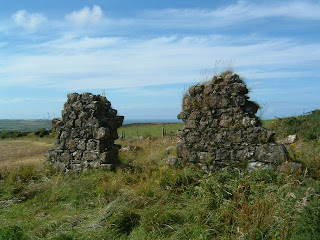
CROAGHMORE
How lovely lies the vale and town
Full to the sun’s glad ray
With heath’ry mountains bleak and brown
And streamlets silvery spray.
Thy vales with verdant beauty drest
Thy mountains I adore
What can the eye more satisfy
Than thou sweet Croaghmore.
Oft on yon mountain’s airy breast
With careless steps I stray
Or climb old Knockan-Ephraim’s crest
And rocks of hoary gray
Or by the old flat stone sit down
To view the landscape oer
Midst which serene she sits a queen
The hill of Croaghmore.
And as adown her rock-bound brow
With leisure gait I roam
Far oer the wide extending plain
View many a peaceful home.
To south gray distance dims the view
To north the sounding shore
And Cushendall’s blue mountain wall
You see from Croaghmore.
And from Fair-head to ‘Derry far
The vast Atlantic tide
Beneath a bright ethereal sky
Rolls in majestic pride.
And when in never-failing strife
It beats the rock-bound shore
Its voice is heard by breezes stirred
Oer thee sweet Croaghmore.
Here crag on crag like step arise
And clad in blossomed heath
As keeping vigil oer the homes
Stretched in the plains beneath.
And lone upon the summit high
Expand three lakes before
The enchanted eye to beautify
The scene of Croaghmore.
And if upon a star-lit night
My steps I thither wend
The sweetly mingling sounds appear
With fairy voice to blend.
While sums the Heaven above to smile
With twinkling tapers oer
Thine Emerald hue and ocean blue
Oh bonnie Croaghmore.
Yet here some ancient ruined walls
Their bitter story tell
Of Christians hunted for the cause
Of Him they loved so well.
And forced to seek the mountains lone
Jehovah to adore
Such was thy past, how changed at last
Thy scenes oh Croaghmore.
E’en such is life, then better far
For those who have believed
Who from the bounteous hand of God
Have life divine received.
They when the eternal morning dawns
Shall hail a nobler shore
And views more grand, a happier land
Than scenes of Croaghmore.
Note: Does anyone know who 'made' this poem? Knockan-Ephraim refers to the placename in Irish: Cnoc an Aifrinn - the hill of the Mass. The top image shows the gable wall as seen from the south east, the middle the ruins from the west and the bottom the new Presbyterian church to the west from close to the ruins.
Croaghmore
How lovely lies the vale and town
Full to the sun’s glad ray
With heath’ry mountains bleak and brown
And streamlets silvery spray.
Thy vales with verdant beauty drest
Thy mountains I adore
What can the eye more satisfy
Than thou sweet Croaghmore.
Oft on yon mountain’s airy breast
With careless steps I stray
Or climb old Knockan-Ephraim’s crest
And rocks of hoary gray
Or by the old flat stone sit down
To view the landscape oer
Midst which serene she sits a queen
The hill of Croaghmore.
And as adown her rock-bound brow
With leisure gait I roam
Far oer the wide extending plain
View many a peaceful home.
To south gray distance dims the view
To north the sounding shore
And Cushendall’s blue mountain wall
You see from Croaghmore.
And from Fair-head to ‘Derry far
The vast Atlantic tide
Beneath a bright ethereal sky
Rolls in majestic pride.
And when in never-failing strife
It beats the rock-bound shore
Its voice is heard by breezes stirred
Oer thee sweet Croaghmore.
Here crag on crag like step arise
And clad in blossomed heath
As keeping vigil oer the homes
Stretched in the plains beneath.
And lone upo the summit high
Expand three lakes before
The enchanted eye to beautify
The scene of Croaghmore.
And if upon a star-lit night
My steps I thither wend
The sweetly mingling sounds appear
With fairy voice to blend.
While sums the Heaven above to smile
With twinkling tapers oer
Thine Emerald hue and ocean blue
Oh bonnie Croaghmore.
Yet here some ancient ruined walls
Their bitter story tell
Of Christians hunted for the cause
Of Him they loved so well.
And forced to seek the mountains lone
Jehovah to adore
Such was thy past, how changed at last
Thy scenes oh Croaghmore.
E’en such is life, then better far
For those who have believed
Who from the bounteous hand of God
Have life divine received.
They when the eternal morning dawns
Shall hail a nobler shore
And views more grand, a happier land
Than scenes of Croaghmore.
Does anyone know who wrote this poem? Knockan-Ephraim comes from an Irish placename on Croaghmore
How lovely lies the vale and town
Full to the sun’s glad ray
With heath’ry mountains bleak and brown
And streamlets silvery spray.
Thy vales with verdant beauty drest
Thy mountains I adore
What can the eye more satisfy
Than thou sweet Croaghmore.
Oft on yon mountain’s airy breast
With careless steps I stray
Or climb old Knockan-Ephraim’s crest
And rocks of hoary gray
Or by the old flat stone sit down
To view the landscape oer
Midst which serene she sits a queen
The hill of Croaghmore.
And as adown her rock-bound brow
With leisure gait I roam
Far oer the wide extending plain
View many a peaceful home.
To south gray distance dims the view
To north the sounding shore
And Cushendall’s blue mountain wall
You see from Croaghmore.
And from Fair-head to ‘Derry far
The vast Atlantic tide
Beneath a bright ethereal sky
Rolls in majestic pride.
And when in never-failing strife
It beats the rock-bound shore
Its voice is heard by breezes stirred
Oer thee sweet Croaghmore.
Here crag on crag like step arise
And clad in blossomed heath
As keeping vigil oer the homes
Stretched in the plains beneath.
And lone upo the summit high
Expand three lakes before
The enchanted eye to beautify
The scene of Croaghmore.
And if upon a star-lit night
My steps I thither wend
The sweetly mingling sounds appear
With fairy voice to blend.
While sums the Heaven above to smile
With twinkling tapers oer
Thine Emerald hue and ocean blue
Oh bonnie Croaghmore.
Yet here some ancient ruined walls
Their bitter story tell
Of Christians hunted for the cause
Of Him they loved so well.
And forced to seek the mountains lone
Jehovah to adore
Such was thy past, how changed at last
Thy scenes oh Croaghmore.
E’en such is life, then better far
For those who have believed
Who from the bounteous hand of God
Have life divine received.
They when the eternal morning dawns
Shall hail a nobler shore
And views more grand, a happier land
Than scenes of Croaghmore.
Sunday 22 July 2007
Bushmills exhibition
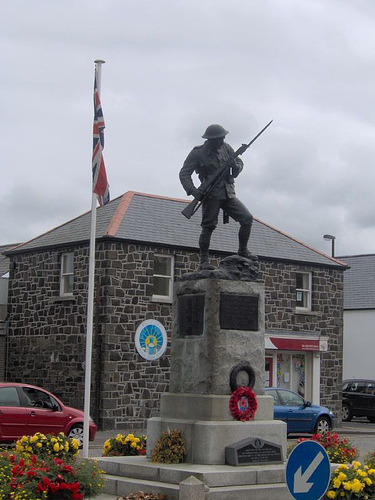
This exhibition displays photographs, personal stories and medals along with memorabilia from both world wars.
It was officially opened on Saturday 21st July 2007 by Major Bill Canning (rtd) of the
In the beginning
 NALIL began on 18 November 2000 when Bob Kane from New Zealand set up an email distribution list among 26 people sharing an interest in a small part of North Antrim.
NALIL began on 18 November 2000 when Bob Kane from New Zealand set up an email distribution list among 26 people sharing an interest in a small part of North Antrim.Bob would receive a message from one of the List members and then circulate the missive using the Bcc function of his emailing program. In 2002 Norman Parkes, from Northern Ireland, took over the administration of the List, and nurtured its growth so that when I - Jennie Fairs, Australia - took over as the List administrator in 2004, membership numbered more than 60.
For some, just receiving a daily dose of NALIL has forged great friendships. Borrowing words from our List archives, “besides genealogy, we have told jokes, shared teaching and travel experiences, family pride stories, medical problems, political observations,” and “recently our pets”.
We are not a Rootsweb or similar type List: “we share, relish, enjoy, waffle and banter … the same as how we see our North Antrim relatives having done …” Some of us have even been fortunate enough to actually “walk the walk” in North Antrim, meeting up with distant family and friends as well as our resident North Antrim members.
Over time, we have benefited enormously from the generous time and effort that some list members have given to various projects – the largest being the transcription of the old burying ground of Billy Parish Church by John A I McCurdy, Shane McCurdy and Norman Parkes.
So as a collection of people – with many personalities and varied interests – we have been lucky to listen and learn from each other and now we hope to share some of our stories through the pages of this blog.
Jennie Fairs
NALIL admin
Subscribe to:
Posts (Atom)
